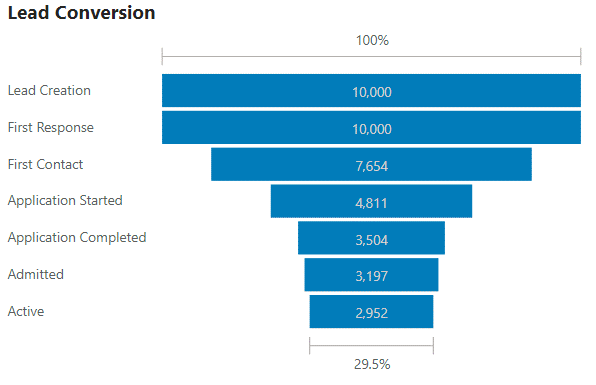Now more than ever before, leaders in higher education are using data to make smarter decisions that improve their institutions, as well as students’ experiences. Often, these data-driven decisions are led by Institutional Research departments, who are focused on student outcomes, retention, attrition, and other academic metrics. However, widening the analytical lens to include data generated at the beginning of a student’s lifecycle, when they are first identified as a lead, can produce more efficient, effective marketing teams, and streamlined enrollment efforts.
The first step to improving marketing and enrollment outcomes is defining what the conversion pipeline is, and what the key components to measure and manage are. Important conversion milestones in the early phase of the student’s journey are:
- Lead creation
- First response – when the school responds to the lead (Speed to Lead)
- First contact – when the lead responds to the school
- Application start date
- Application completion date
- Conversion from applicant to admitted student
- Conversion from an admitted student to an active, revenue-generating student
Critical questions and metrics are:
- How many leads convert at each step in the pipeline?
- What content does the lead see and interact with before converting, both on the website and in contact efforts? Are there any affinity-generating activities the lead attends (campus tours, webinars, events, etc.)?
- How long does each conversion step take?
- How do the above vary across attributes like degree level, program, student demographics, enrollment team member, etc.?
Sample conversion funnel created in Power BI
After the student has completed this first lead generation activity it’s important to have a well-defined, well-managed, and well-measured contact strategy. Speed to Lead – the time from when a lead first completes a form to the first moment the enrollment team has the chance to contact them – is the first key metric to measure. Conversion rates are generally higher when leads are contacted immediately. Understanding when inbound leads are created, as well as the time it takes for your enrollment team to respond, can help inform:
- Staffing decisions; after all, someone needs to be available to respond to inbound leads.
- What auto-response to craft for leads received off-hours.
- How many new leads can one enrollment team member reasonably handle in their queue? If Speed to Lead times are slow, perhaps consider shifting workloads or adding additional resources.
The third step in the conversion pipeline is the First Contact, when the student responds to outreach attempts from the enrollment team. This may happen during the initial, first response from the enrollment team, or may happen after subsequent outreach attempts. Many schools have defined workflows for their contact strategy, made up of a combination of emails, phone calls, and SMS messages. Knowing which outreach attempt produced results, and which the student received prior to the contact event, can inform messaging content.
The next points of conversion are for the student to begin their application (if that was not their original lead source) and then to complete that application. This is a key step in the enrollment journey: understanding the time from lead generation to applicant conversion can inform timing of marketing campaigns, and knowing the amount of time/effort spent on outreach and communication with the student can be incorporated into Cost per Lead metrics.
The next step in the conversion pipeline, the status change from applicant to admitted student, can be either passive or active, depending on what – if any – materials or fees the student has outstanding. Here again is another opportunity to measure the number of contacts between the student and the school, and the time it takes to complete this conversion step.
Finally, an admitted student will convert to an active, revenue-generating student. At this point, we can analyze the information the student received prior to enrollment to help understand their preparedness; did they receive content regarding tuition, financial aid, academic support resources, etc.? A school can incorporate these data points from the CMS or CRM into a predictive model for student success. Here again, understanding the time it takes to convert to an active student is critical to successful campaign planning. There is also opportunity to measure conversion by enrollment team member to identify areas of strength, and occasions for growth and coaching.
3Cloud can help you optimize lead conversion and enrollment strategy at your educational institution. Whether that solution starts with building a new Azure SQL Data Warehouse, incorporating predictive analytics and machine learning, or using Power BI to build engaging, interactive reports and visualizations, we are here to help.






